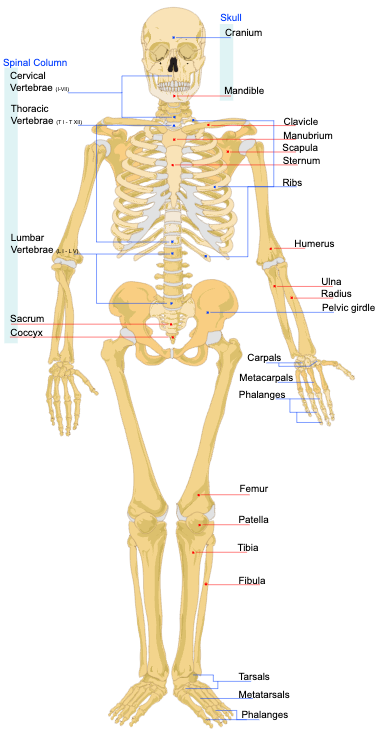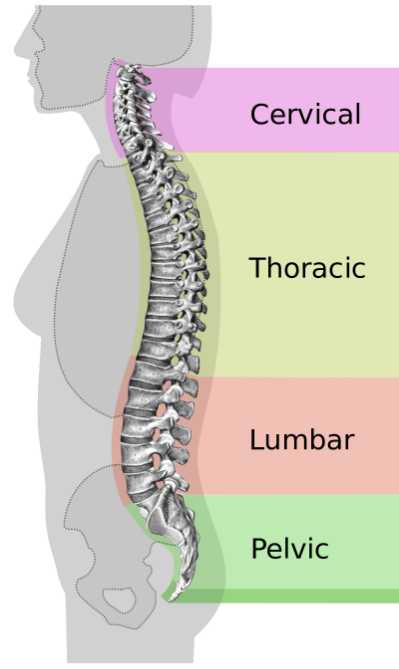A bone is a rigid structure with a high concentration of minerals that makes up the skeleton of humans and other vertebrates.
There are several categories of bones in the skeleton.
-
Long bones, such as the femur or humerus.
-
Short bones, such as the carpals or tarsals.
-
Flat bones, such as the sternum or scapula.
-
Irregular bones, such as the vertebrae or jawbone.
This concept sheet focuses mainly on long bones.
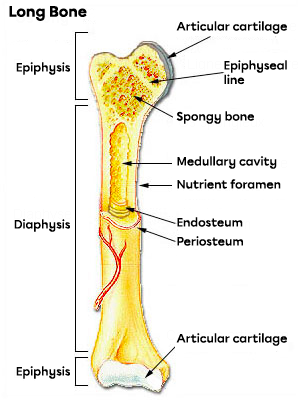
Long bones are made up of two types of bone tissue: spongy bone and compact bone. Located primarily at the two ends of the long bone, called the epiphyses, the spongy bone is filled with pores, much like a sponge. This type of bone tissue contains the red bone marrow that produces the various blood cells: red blood cells, white blood cells and platelets. The amount of red bone marrow decreases with age and is only present in the epiphysis of certain bones in adults.
The compact bone is found in the diaphysis, which is the central part of the long bone. Inside the bone, there is the yellow bone marrow, which is mostly made up of lipids. These are fats that can be used by the body as a source of energy if the need arises.
The following table shows the different parts of the long bone and their respective functions.
|
|
Parts | Functions |
| Diaphysis | Periosteum |
|
| Compact bone |
|
|
| Yellow bone marrow |
|
|
| Epiphysis | Red bone marrow (in spongy bone) |
|
| Articular cartilage |
|
|
| Growth cartilage |
|
Chemical Composition of Bones
Bone tissue contains both organic and inorganic constituents. The right combination of the two gives healthy bones half of steel’s stiffness under pressure and the same resistance to tension. Elasticity and resistance to torsion and bending are ensured by the collagen fibres, while resistance to compression is ensured by the mineral part of the bone.
The organic constituents
The main organic constituents of bone are the cells: osteoblasts, osteocytes and osteoclasts. The organic part of the matrix (the support) is called the osteoid material. This material, which constitutes approximately one third of the mass of the matrix, is mainly composed of different proteins that are secreted by the osteoblasts. First, there are fibrous proteins, 80% of which is collagen, which gives the bone a strong and flexible structure. Then, there are globular proteins that contribute to the mineralization of the bone. The composition and proportions of the constituents of bone are absolutely fundamental in determining its level of flexibility and resistance to torsion and bending.
Inorganic constituents
These constituents make up about 65% of bone mass. The main component is a mineral salt composed of calcium phosphate, which is called hydroxyapatite |(\text{Ca}_{10}\text{(PO}_4)_6\text{(OH)}_2).| It is organized around collagen fibres in the form of tightly packed crystals. These materials make the bone extremely resistant to compression. Finally, bone may contain potassium, magnesium and sodium, in addition to certain heavy metals and/or radioactive elements that may be present if the person has been in contact with these elements during their life.
The skull contains 8 cranium bones and 14 facial bones, excluding the ossicles of the ear.
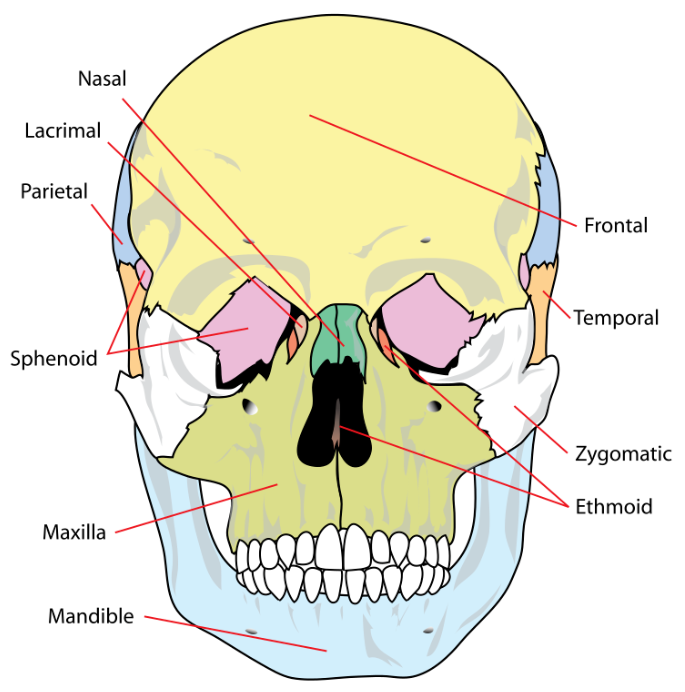
The cranium bones, which are quite flat, form a cavity that contains various liquids and membranes to protect the brain. These bones are fused together, but they’re still delineated by the sutures, which are joint lines that become immovable by the age of 2.
The bones of the face have diverse irregular shapes. They give shape to the face in addition to supporting the sensory organs and allowing the nerves to pass. They’re all fixed, except for one, the mandible, which enables chewing and word articulation.
The rib cage, also called the thoracic cage, (sternum and 12 pairs of ribs) and the spinal column, also called the vertebral column, (33 vertebrae) are located in the trunk.
The first 10 pairs of ribs are connected to the sternum by cartilage. The last two pairs, called floating ribs, aren’t connected to the sternum. The rib cage protects several organs, such as the heart and lungs, from impact and injury. The muscles between the ribs (intercostal muscles) allow for respiratory movements.
The spinal column has 24 vertebrae separated by intervertebral discs, which make them mobile. The 9 fused vertebrae are located at the sacrum and coccyx. All vertebrae have an opening in the centre, called the vertebral canal, where the spinal cord passes through. The flexibility and strength of the spinal column allows the body to maintain balance and move around.
The arms are connected to the trunk by the shoulder, which is a joint made up of the clavicle and the scapula, called the shoulder girdle. The section from the shoulder to the fingertips consists of the following bones: the humerus, the radius, the ulna, the carpals (8 bones), the metacarpals (5 bones) and finally the phalanges (14 bones).
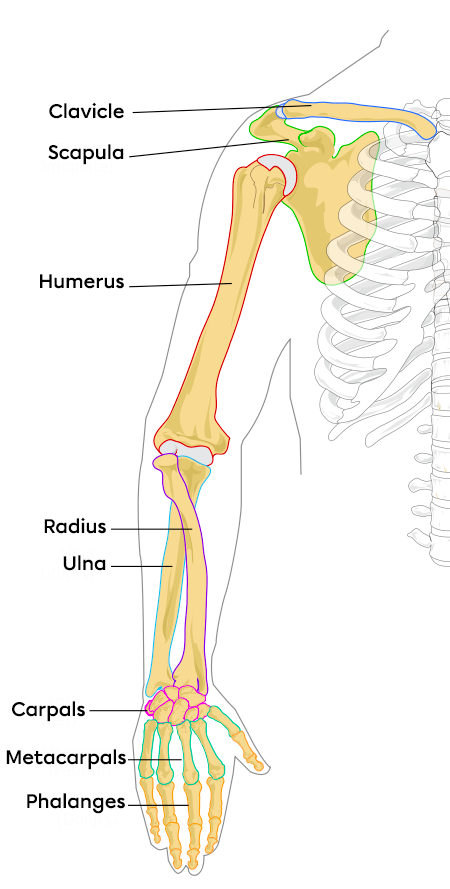
The way the shoulder articulates allows the arm to move in almost any direction. The hands are able to grip objects. In other words, the large number of small bones in the hand makes it agile enough to pick up objects.
Each leg is connected to the trunk by the pelvic girdle. The femur, the single thigh bone, is the longest bone in the human body. It joins the tibia at the knee through the patella. Next to the tibia is a thinner bone, the fibula. In addition to these bones, there are those of the ankle and the foot.
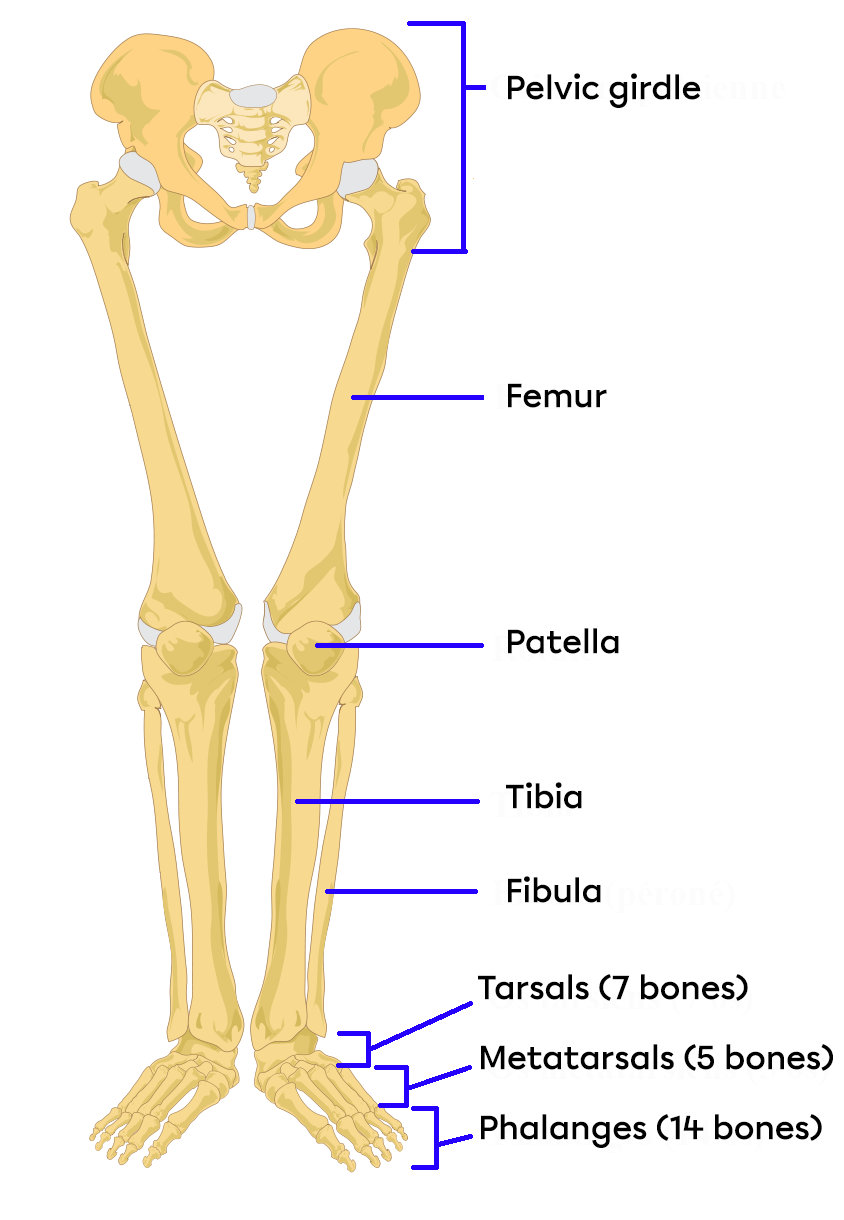
In addition to supporting all the weight of the body, the lower limbs allow a person to move, especially with the help of the large muscles of the thighs and the rest of the leg.
